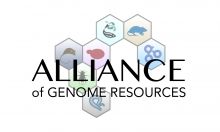SGD Newsletter, Summer 2024
About this newsletter:
This is the Summer 2024 issue of the SGD newsletter. The goal of this newsletter is to inform our users about new features in SGD and to foster communication within the yeast community. You can view this newsletter as well as previous newsletters, on the SGD Community Wiki.
Contents
[hide]Ref genome update R64.5
Extend gene coordinates in GFF
The saccharomyces_cerevisiae.gff contains sequence features of Saccharomyces cerevisiae and related information such as Locus descriptions and GO annotations. The saccharomyces_cerevisiae.gff is fully compatible with Generic Feature Format Version 3, and is updated weekly.
After November 2020, SGD updated the transcripts in the GFF file to reflect the experimentally determined transcripts (Pelechano et al. 2013, Ng et al. 2020), when possible. The longest transcripts were determined for two different growth media – galactose and dextrose. When available, experimentally determined transcripts for one or both conditions were added for a gene. When this data was absent, transcripts matching the start and stop coordinates of an open reading frame (ORF) were used.
 Old version: BDH2/YAL061W with longest transcripts expressed in GAL and in YPD.
Old version: BDH2/YAL061W with longest transcripts expressed in GAL and in YPD.
Beginning in February 2024, SGD increased the start and stop coordinates of genes to encompass the start and stop coordinates of the longest experimentally determined transcripts, regardless of condition. This change was made in order to comply with JBrowse 2, a newer and more extensible genome browser, which requires that parent features in GFF files (genes) are larger than child features (mRNA, CDS, etc) (Diesh et al., 2023).
 After February 2024: BDH2/YAL061W with increased start/stop coordinates.
After February 2024: BDH2/YAL061W with increased start/stop coordinates.
This is a standard format used by many groups. SGD uses the GFF file to load the reference tracks in SGD’s genome browser resource.
Updates to SGD search
datasets complex aliases allele descriptions, SGDIDs RNAcentral IDs
PubTator link on SGD reference pages
microPublications - latest yeast papers
microPublication Biology is part of the emerging genre of rapidly-published research communications. We are seeing a strong set of microPublications come through the database and are glad for this venue to publish brief, novel findings, negative and/or reproduced results, and results which may initially lack a broader scientific narrative. Each article is peer-reviewed, assigned a DOI, and indexed through PubMed and PubMedCentral.
Consider microPubublications when you have a result that doesn't necessarily fit into a larger story, but will be of value to others.
Latest yeast microPublications:
- Caligaris M, De Virgilio C (2024) Proxies introduce bias in decoding TORC1 activity. MicroPubl Biol 2024.
- Fromont-Racine M, Khanna V, Jacquier A, Badis G (2024) YLR419W is the homolog of the mammalian translation initiation factor DHX29. MicroPubl Biol 2024.
- Greenlaw A, Dell R, Tsukiyama T (2024) Initial acidic media promotes quiescence entry in Saccharomyces cerevisiae. MicroPubl Biol 2024.
- Harmer ZP, Hohener TC, Landolt AE, Mitchell C, McClean M (2024) Enhancing high-throughput optogenetics: Integration of LITOS with Lustro enables simultaneous light stimulation and shaking. MicroPubl Biol 2024.
- [https://www.yeastgenome.org/reference/S000347552 Karpel JE (2024) Caenorhabditis elegans ddx-15 helicase fails to complement loss of Prp43p in Saccharomyces cerevisiae. MicroPubl Biol 2024.
- Medina-Suarez S, Machin F (2024) The CRISPR/Cas9 system forms a condensate in the yeast nucleus. MicroPubl Biol 2024.
- Putnam CD (2024) Loss of mitochondrial DNA is associated with reduced DNA content variability in Saccharomyces cerevisiae. MicroPubl Biol 2024.
- Rosenbaum JC, Carlson AE (2024) The SARS coronavirus accessory protein ORF3a rescues potassium conductance in yeast. MicroPubl Biol 2024.
All yeast microPublications can be found in SGD.
Alliance of Genome Resources - Release 7.1
The Alliance of Genome Resources, a collaborative effort between SGD and other model organism databases (MODs), released version 7.1 in May 2024.
The 7.1.0 release updates the Disease pages’ Associated Genes table:
- A new column contains Disease Qualifier, which describes whether an allele may be, for example, implicated in the onset of a disease or implicated in the severity of a disease.
- The “Annotation Details” pop-up now includes more information: Association, Additional Implicated Genes, Genetic Modifiers, Genetic Sex, Strain Background, Notes, and Annotation Type.
- The Download file from the disease page Associated Genes table now includes Additional Implicated Gene ID, Additional Implicated Gene Symbol, Gene Association, Genetic Entity Association, Disease Qualifier, Evidence Code Abbreviation, Experimental Conditions, Genetic Modifier Relation, Genetic Modifier IDs, Genetic Modifier Names, Strain Background ID, Strain Background Name, Genetic Sex, Notes, Annotation Type, and Source URL.
- On the highest-level, generic “disease” page and other applicable pages:
- There is now a 90,000 row limit on how many rows can be downloaded at any given time.
- There is a message in red text at the bottom of any table displaying more than 90,000 rows: “The table above cannot be downloaded because there are too many rows in the unfiltered table. Please apply filter(s) to limit the number of rows to less than 90000 to enable the Download button or visit our Downloads page to download the entire data set.”
- This table now loads quickly and consistently; due to the amount of data this table had been previously slow to load.
Upcoming conferences and courses
- RCN-UBE: Yeast ORFan Gene Project - Summer Workshop - Gene Expression Analysis
- June 20 to June 21, 2024
- Virtual
- FASEB Yeast Chromosome Biology and Cell Cycle
- June 23 to June 27, 2024
- Fort Garry Hotel, Winnipeg, Manitoba, Canada
- JCS2024: Diversity and Evolution in Cell Biology
- June 24 to June 27, 2024
- Montanya Hotel & Lodge, Catalonia, Spain
- Pacific Northwest Yeast Club
- July 26, 2024
- Fred Hutchinson Cancer Center, Seattle, WA
- 39th Small Meeting of Yeast Transporters and Energetics (SMYTE)
- August 28 to September 01, 2024
- University of York, York, United Kingdom
- ICY2024: 16th International Congress on Yeasts
- September 29 to October 03, 2024
- Cape Town International Convention Centre, Cape Town, South Africa
- Yeast2025: 32nd International Conference on Yeast Genetics and Molecular Biology ICYGMB32
- July 21 to July 24, 2025
- Sorbonne University, Paris, France

